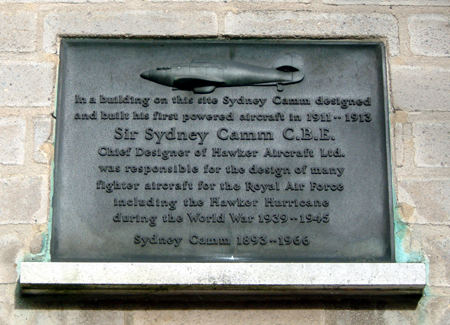Sir Sydney Camm CBE, FRAeS (5 August 1893 – 12 March 1966)
Sydney Camm was born on 5th August 1893, at 10 Alma Road in Windsor, the eldest child of the twelve children of Frederick Camm, a journeyman carpenter and joiner and Mary Smith.
In 1901 he attended the Royal Free School on Bachelors Acre in Windsor. In 1906 he was granted a Foundation Scholarship. In 1908 at the age of 14 Camm left school to become an apprentice carpenter.
Camm developed an interest in aeroplanes and he and his brothers began building model aircraft which they supplied to Herbert’s Eton High Street shop. After finding that they could obtain a higher price they began making direct sales to boys at Eton College, which were delivered in secret to avoid attracting the attention of Herbert and the school authorities.
Camm’s brother Fred, also a competent modeller and designer became editor of the famous Practical series of magazines,
These activities led Sydney to become one of the founders of the Windsor Model Aeroplane Club. In 1912 with other club members he built a man-carrying glider which actually flew.
There is a commemorative plaque on the wall of Athlone Square, Ward Royal, on the site of the workshop where the glider was built.
In 1914 Camm joined the Martinsyde aircraft company located at the Brooklands racing circuit in the position of Shop-floor carpenter after proving his ability he was promoted to the drawing office. In 1919 he published a handbook entitled Aeroplane Construction.
Following the company going bust in 1921, Camm went to work for George Handasyde who had created the Handasyde Monoplane.
In 1923 Camm joined the Hawker Aircraft Company successor to the Sopwith Aviation Company Ltd, ( Later Hawker Siddeley) as a senior draughtsman. At first Camm designed the Hart ‘family’ of fabric and metal biplanes, including the Cygnet which led on to him being appointed chief designer in 1925.
In 1925, in association with Fred Sigrist, Hawker’s managing director, Camm developed a form of metal construction that used jointed tubes as a cheaper and simpler alternative to welded structures.
During his employment at Hawker he was responsible for the creation of 52 different types of aircraft, of which a total of 26,000 were manufactured. Amongst his early designs were the Tomtit, Hornbill, Nimrod, Hart and Fury. At one time in the 1930s 84 per cent of the aircraft in the RAF were designed by Camm.
He then moved on to designing aeroplanes that would become mainstays of the RAF in the Second World War including the Hawker Hurricane, Hawker Typhoon, Hawker Tempest and the Sea Fury.
The iconic Hawker Hurricane was in full production at the outbreak of war and formed a major part of Fighter Command strength during the Battle of Britain.
The News Chronicle hailed Camm as the man who saved Britain and he was made a CBE in 1941.
After the war Camm developed jet-powered designs the Harrier and Hunter.
Sydney Camm was knighted 2 June 1953, on the occasion of the coronation of Queen Elizabeth II.
Camm was President of the Royal Aeronautical Society (RAeS) from 1954 to 1955
Camm retired as chief designer at Hawker in 1965, but remained on the board of its successor, Hawker Siddeley until his death.
Camm died on 12th March 1966 aged 73 whilst playing golf.
The Times called him “one of the most consistently successful designers the aircraft industry has ever had” Sir Thomas Sopwith credited him with being the greatest designer of fighter aircraft the world had ever known.
The full size replica (Top of Page) is a lasting memorial to Windsor resident Sir Sydney Camm CBE FRAeS (1893-1966). It bears the markings of an aircraft flown in the Battle of Britain by Squadron Leader John Grandy who, as Marshal of the Royal Air Force Sir John Grandy GCB GCVO KBE DSO KStJ, was Constable and Governor of Windsor Castle from 1978-88.





